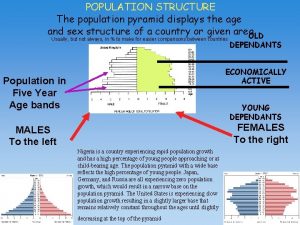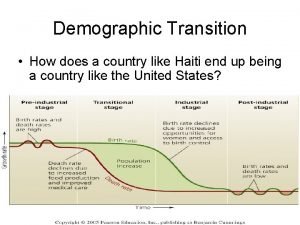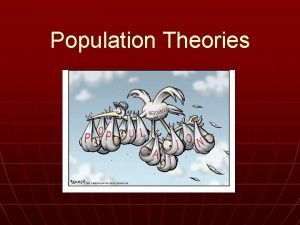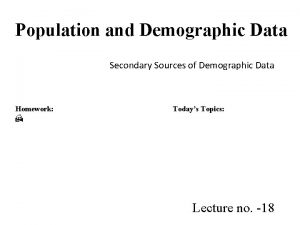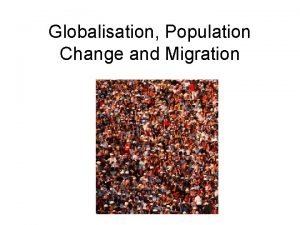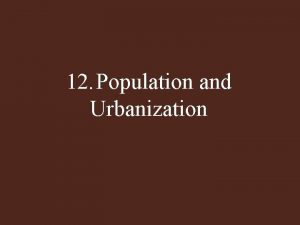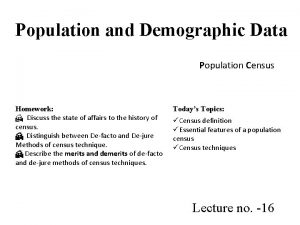Why Is Population Increasing at Different Rates Demographic











































- Slides: 43

Why Is Population Increasing at Different Rates? • Demographic transition – Four stages • Stage 1: Low growth – Agricultural revolution • Stage 2: High growth – Industrial Revolution • Stage 3: Moderate growth • Stage 4: Low growth – Zero population growth (ZPG)

Demographic Transition Figure 2 -15

Stage 1: Very high birth and death rates produce virtually no long term increase. During this period people depended on hunting and gathering for food. When food was easily attainable a regions population increased.

Stage 2: Rapidly declining death rates combined with very high birth rate produce a very high natural increase. For nearly 10, 000 years after the Agricultural Revolution world population grew at a modest pace. In 1750 the worlds population starts to grow 10 xs faster.

Hans Rosling: 200 Years that Changed the World

Stage 3: Birth rates rapidly decline, death rates continue to decline, and natural increase rates begin to moderate. The sudden drop in the CBR during stage 3 occurs for different reasons than the rapid decline of the CDR during stage 2. `

Stage 4: Very low birth and death rates produce virtually no long-term natural increase, and possibly a decrease.

Demographic Transition Figure 2 -15

Why Is Population Increasing at Different Rates? • Demographic transition & world population growth – Most countries = stage 2 or stage 3 of the Demographic Transition • Stages 2 and 3 are characterized by significant population growth – No country is in stage 1 of the demographic transition – It is easier to cause a drop in the CDR than in the CBR

Why Might Overpopulation be a Concern? • Malthus on overpopulation – An Essay on the Principle of Population (1798): Population grows geometrically while food supply grows arithmetically – Criticism of Malthus includes the following: • Pessimistic viewpoint • Failure to consider technological innovation

What future growth rate is assumed by the high projection?

If the high projection is accurate, people could suffer from food, energy, and water shortages, increased air and water pollution, and increased global warming. For each projection, what would be some consequences if it turned out to be accurate?

Which prediction do you think is the most desirable? The most likely to happen?


The Demographic Transition is a transition from what to what?

From a small population with short, difficult lives to a larger population with longer lives.

What explains the decrease in the death rate?

People are healthier because more food is available and because health care and sanitation improved.

What explains the increase in the birthrate?

Because people live longer, the population of childbearing age grows.

What explains the increase in population?

More people are being born and they are living longer.

Why does the birthrate begin to fall again?

In agricultural societies, children are needed by families as labor. Advances in technology provide replacement for human labor power so children less needed.

Is there likely to be a population crisis?

Pessimistic Approaches • Thomas Malthus (1776 -1834) • Wrote “An essay on the Principle of Population” in 1798 which described a forthcoming population catastrophe • World population was then nine million • World population has now grown to SEVEN billion

Malthus’ Core Principles • Food is essential for life • Population increases faster than food supply ----------------------------Therefore, Malthus predicted that population would grow until it reached the limit of food supply, then there would be widespread poverty and famine.

Malthus recognized that: Population, if left unchecked, will grow geometrically: 1, 2, 4, 8, 16, 32 Whereas food supply increases arithmetically as the amount of land is finite: 1, 2, 3, 4, 5, 6

And therefore he said … ly d Foo p sup n tio a l u Pop Time At the point where population reaches its limit of food supply there will be war, famine and disease. Food supply Population … there would be a Malthusian catastrophe!

Malthusian Checks • Malthus stated that once population reached this point, checks would come into play to readdress the balance between population and resources: 1. “positive” checks – increased levels of misery (war, famine and disease) 2. preventative checks – celibacy, later marriage etc

So, was Malthus right? Thoughts?

Was Malthus right? • Evidence to support Malthus: – There has been a population explosion – Repeated wars & famines in Sahel region of Africa suggest population growth has outstripped food supply – FAO says that more than 800 m people are chronically malnourished – UN say that by 2050 4. 2 Billion people will be living in areas that cannot provide enough water for basic needs.

The Sahel region of Of Africa

But … • Critics say that Malthus did not allow for: – the development of new technology – The opening of new land for cultivation (mainly in LDCs) – The development of irrigation systems which have allowed for increased yields – The Green Revolution – widespread introduction of high-yield crop varieties, pesticides, fertilizers etc – The slow down in population growth as countries develop economically and progress to the latter stages of the DTM - Demographic Transition Model.

Neo-Malthusians • Neo = new • Accelerated population growth in LDCs since the 1950 s renewed Malthusian fears • 1972, The Club of Rome published “Limits to Growth Model”

Club of Rome – basic conclusion • If present growth trends continue, and if associated industrialization, pollution, food production and resource depletion continue unchanged, the limits to growth on this planet will be reached some time in the next one hundred years. • The most probable result being a sudden & uncontrollable decline in population and industrial capacity.

Is the Club of Rome right? • Don’t panic yet!!! • Doesn’t take into account the ability of humans to respond to situations and innovate • Human responses have changed e. g. alternative energy, High Yield Variety seeds sent to Africa

A more optimistic approach • Ester Boserup (1910 -1999 • Wrote “The Conditions of Agricultural Growth” in 1965 • Opposite to Malthus • People have resources of knowledge and technology to increase food supply as necessary

Boserup’s main points • Environments have limits that restrict population • But these limits can be changed using technologies • Population growth is the trigger for innovation to allow food supply to increase • e. g. irrigation, weeding, crop intensification, better seed quality, tools, techniques etc

Was Boserup right? • Evidence which supports Boserup: – Increasing intensity of shifting cultivation – Move from ‘slash and burn’ practices to using irrigation in rural areas with higher population densities – The Green Revolution – widespread introduction of high-yielding varieties, pesticides etc – Hugely increased yields allowed more people to be fed – GMOs – Genetically Modified Organisms

Was Boserup right? • Boserup admits that overpopulation can lead to unsuitable farming practices which may degrade the land • E. g. population pressure as one of the reasons for desertification in the Sahel region

What Do You Think?

Malthus & Boserup • There is evidence to suggest that the ideas of Malthus and Boserup may be appropriate at different scales. • On a global level the growing suffering and famine in some LDCs may reinforce Malthusian ideas. • On a national scale some governments have been motivated by increasing populations to develop their resources to meet growing demands.
 Demographic transition model population pyramids
Demographic transition model population pyramids Unit ratio
Unit ratio Ratios rates and unit rates guided notes
Ratios rates and unit rates guided notes Ratios rates and unit rates
Ratios rates and unit rates Ratios rates and unit rates
Ratios rates and unit rates Hey bye bye
Hey bye bye Why do different polymers have different properties
Why do different polymers have different properties Why do different atoms produce different colors
Why do different atoms produce different colors 2 candles burn at different rates
2 candles burn at different rates Chapter test a chapter 4 population ecology answer key
Chapter test a chapter 4 population ecology answer key Population ecology section 1 population dynamics
Population ecology section 1 population dynamics Population ecology section 1 population dynamics
Population ecology section 1 population dynamics Chapter 4 section 1 population dynamics study guide answers
Chapter 4 section 1 population dynamics study guide answers Dont ask why why why
Dont ask why why why Different types of population pyramids
Different types of population pyramids Demographic transition model ap human geography
Demographic transition model ap human geography Uk demographic transition model
Uk demographic transition model Epidemiological transition model
Epidemiological transition model Tesla mission statement
Tesla mission statement Theory of demographic transition
Theory of demographic transition Demographic momentum ap human geography definition
Demographic momentum ap human geography definition Demographic transition theory
Demographic transition theory Demographic stochasticity
Demographic stochasticity Demographic psychographic and geographic
Demographic psychographic and geographic How to segment a market
How to segment a market Demographic transition model ap human geography
Demographic transition model ap human geography On formalizing fairness in prediction with machine learning
On formalizing fairness in prediction with machine learning Demographic data definition
Demographic data definition Demographic transistion model
Demographic transistion model Warren thompson's demographic transition model
Warren thompson's demographic transition model Haiti demographic transition model
Haiti demographic transition model Demographic transition model stages
Demographic transition model stages Primary segmentation
Primary segmentation Rimland theroy
Rimland theroy Un demographic yearbook
Un demographic yearbook Demographic cohort
Demographic cohort Pringles brand positioning
Pringles brand positioning Demographic transition model worksheet
Demographic transition model worksheet Recent demographic changes in the uk
Recent demographic changes in the uk China demographic dividend
China demographic dividend Two big breaks in the demographic transition
Two big breaks in the demographic transition Demographic transition model song
Demographic transition model song Starbucks demographic segmentation
Starbucks demographic segmentation Sources of demographic data
Sources of demographic data
